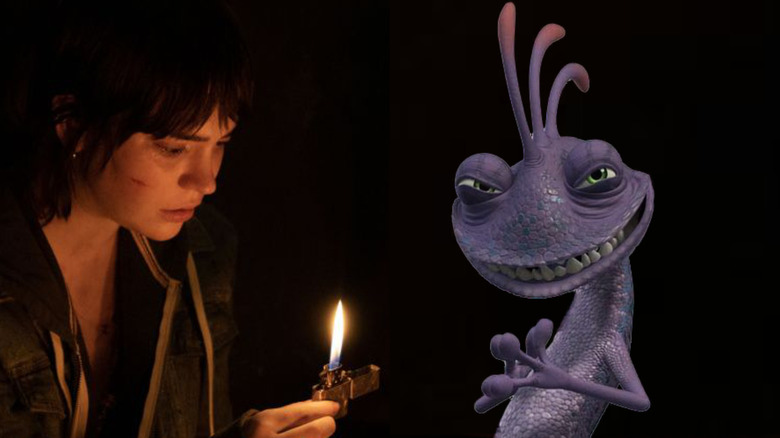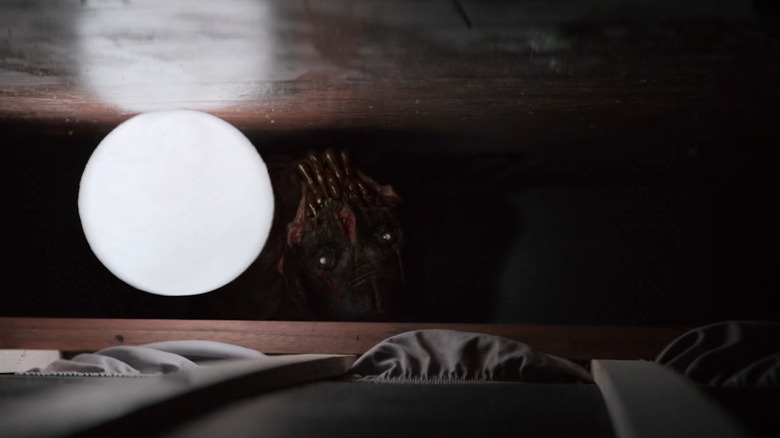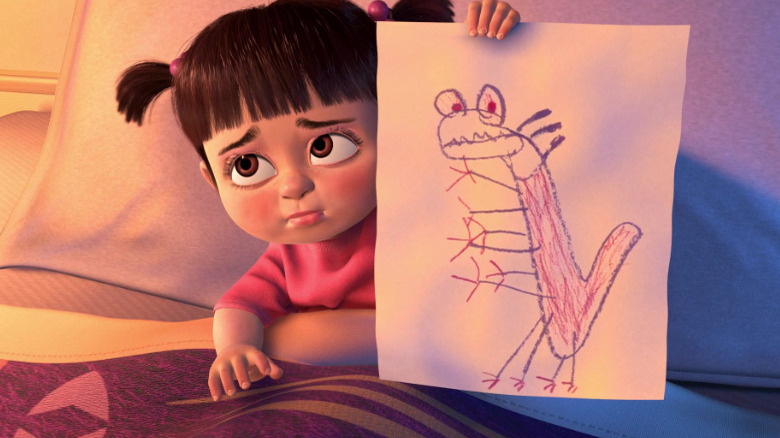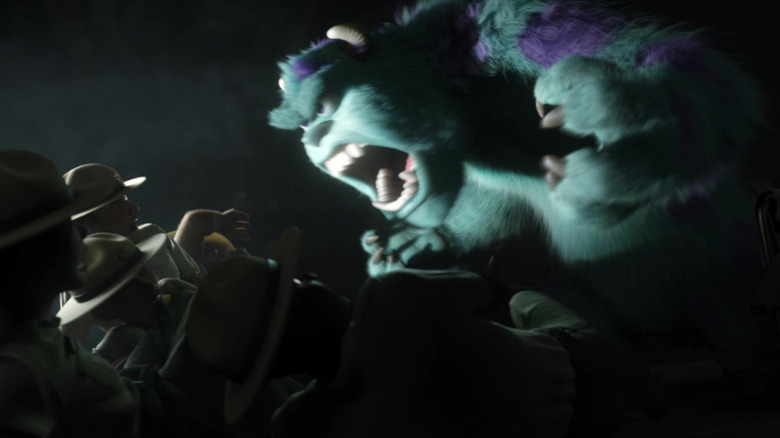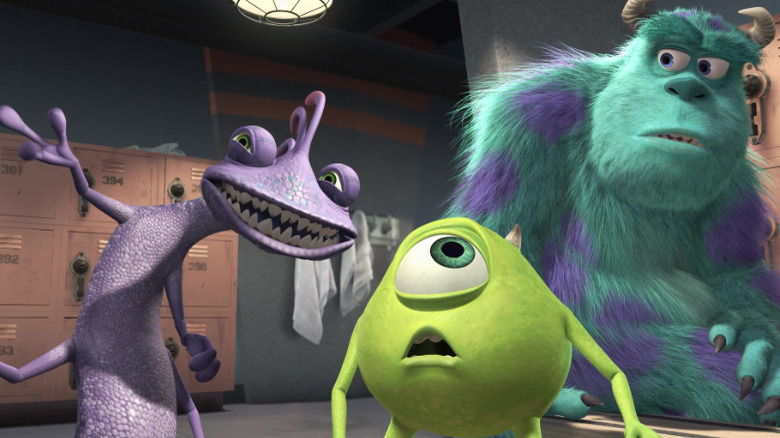What If Stephen King's Boogeyman Is Just Randall From Monsters, Inc.?
Film criticism is a multifaceted art form in which we discuss the voluminous elements of a complex art form, challenging our assumptions of formalism, exploring our capacity for empathy, contextualizing historical texts, and sharing deeply personal insights about the way movies affect us individually. At its best, film criticism is a noble endeavor that illustrates the myriad ways that this, the most popular art form of the last century-plus of human history, affects every single one of us (often in ways we don't always consciously comprehend).
So when I put it to you that the main bad guy from the Stephen King adaptation "The Boogeyman" is actually just Randall from the animated "Monsters, Inc." movies, I'm either betraying the entire noble history of my profession or being deeply, disturbingly confessional. Maybe this is the silliest thing I've ever written (which is saying something), or maybe it's an earnest admission that motion pictures have completely rewired my brain from the bottom upwards, and my tendency to draw connections between elements of cinematic storytelling is now almost completely outside of my control. This is who I am now, for better or worse, and I lay my subconsciousness bare before you, and implore you to either try to view the world through my very particular lens, or at least not judge me too harshly.
For the record, I don't mind if you laugh.
And for the record, yes, I think the monster in Rob Savage's "The Boogeyman" is literally just Randall from "Monsters, Inc."
King me
"The Boogeyman" is an adaptation of a short story by Stephen King, originally published in 1973, about a man tortured by a monster who emerges from his closet and torments and kills his children. King's voluminous short stories and novels have been strip-mined by Hollywood, steadily and consistently, ever since "Carrie" came out in 1976, yet it took 50 whole years for a feature film adaptation of "The Boogeyman" to reach theaters.
Directed by Rob Savage (who also helmed the found footage supernatural thriller "The Host," one of the great masterpieces of the Lockdown Wave), this version of "The Boogeyman" quickly burns through the majority of King's short story in its opening minutes, leaving the rest of the movie free to expand upon its premise. For better or worse, Savage turns "The Boogeyman" into a monster flick à la "The Babadook" or, more specifically, "Lights Out," with the title creature attacking two children, scaring the bejeezus out of them, and resorting to a variety of boo scares and lighting gags.
The monster in "The Boogeyman" is never seen clearly on camera, at least not for long, but we know it likes to live in closets, that it can walk on walls, that it's an expert at hiding in plain sight, and that it really, really hates kids and likes scaring them.
Does that remind you of anybody?
The sum of Randall fears
Randall is a character who spent his whole career working in closets. He can walk on walls. He's an expert at hiding in plain sight. And he really, really hates kids and likes scaring them. As a member of the scare team at "Monsters, Inc.," he dedicated his life to the art of terrifying children and eventually took the job too far, not just frightening them but abducting them and placing them in real peril. Heck, both Randall and "The Boogeyman" inspire children to draw creepy, amateurish (I don't meant to judgmental, but let's be fair) drawings of their creepy visages.
Those aren't just "lels," that's a whole pair of "lels." "Parallels," if you will.
It looks like "The Boogeyman" disappears whenever the lights turn off, but we know it can be seen with the lights on, which suggests that it's not only visible in certain forms of illumination but instead is very good at hiding. Randall is a literal chameleon. He could be anywhere at any time.
Further, "The Boogeyman" is seen climbing up walls, and we know Randall can do that too. They also both have giant creepy mouths. Heck, "The Boogeyman" can mimic the voices of his prey and their family members, and in "Monsters University" we learn that scary monsters literally have to go to acting classes in order to adapt to the fears of their victims. Randall is classically trained. It's extremely reasonable to assume he can copy your dad's accent and tone of voice.
Of course, simply pointing out that "The Boogeyman" and Randall have exactly the same skillsets and very similar physical characteristics doesn't mean that they're the same person. To do that, you'd have to explain why Randall is now in the real world with a grudge against kids.
And "Monsters, Inc." already did that.
Monsters act two - back in the habit
"Monsters, Inc." concludes with Randall getting banished to the human world — our world — for his crimes. We've seen this play out multiple times in the "Monsters" movies, and every time the monster is left with no recourse but to play the role of a monster, and establish itself within the human preconception of monsters.
In "Monsters, Inc.," we see the character Yeti living his life as the Abominable Snowman, even though he's hardly all that abominable. And in "Monsters University," when Mike and Sulley get trapped in the human world, they find themselves in a summer camp ripped directly from a 1980s horror movie, with eerie lighting and creepy imagery galore. The only way to escape is for Sulley to become a campfire story monster himself.
How would Randall adapt to the human world? Well, again, he likes closets, he hates kids, he's probably got a vengeful streak building inside of him, and he absolutely fits the human preconception of the so-called "Boogeyman." If the shoe fits, Randall probably figured he should wear it. And without any monsters to talk to, instead living in isolation in the shadows of a strange civilization that hates and fears him, it makes sense that he'd lose himself in the role and become every bit the monster kids always assumed he was.
So it goes that he spends his time performing the only task he was ever good at — namely scaring kids to death — but now he does it literally. How fitting that his transformation from one type of monster to another, and his traversal from one world to another, would take the meta-textual form of traversing from one studio to another: from Disney's family-friendly Pixar to Disney's horror-friendly 20th Century Studios.
Big Dis energy
Randall was always talking about the winds of change, the evolution of merely scaring people a little to scaring them senseless. Meanwhile, Disney has changed, and now openly embraces the intellectual properties it owns — thanks largely to acquiring 20th Century Fox (now just "20th Century Studios") — that are firmly within the horror realm. They already released a "Predator" prequel, the excellent "Prey," and they're working on a TV series based on one of cinema's most terrifying monsters, the xenomorph from "Alien."
And while it's unlikely that anyone at Disney literally intended for the monster in Rob Savage's "The Boogeyman" to be the next evolution of Randall from "Monsters, Inc.," it's nevertheless the same kind of brand synergy Disney makes billions off of. Hell, they retold the story of "Sleeping Beauty" from the villain's perspective, and somehow used the same story structure as films like "Ms. 45." The lines between family friendly and horror are blurring over there. Perhaps Randall really was ahead of his time. Maybe this has all been the greatest and most important observation anyone has ever made about a movie.
Or perhaps my brain has been transformed into utter sludge by the Disney corporation. Either way, I think it's kinda fun to think about.
"The Boogeyman" is now playing in theaters.
